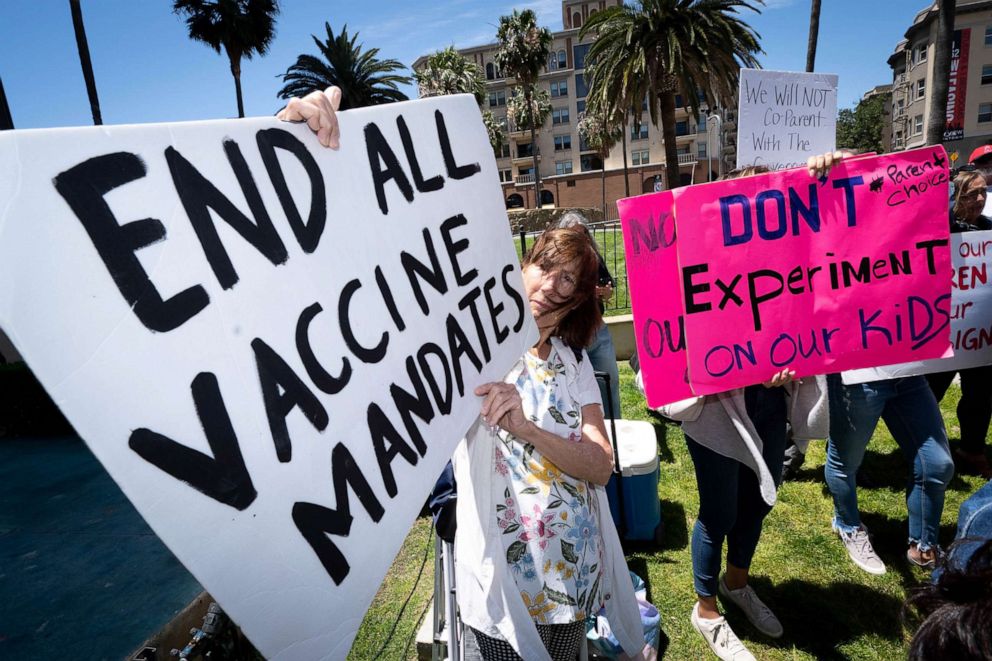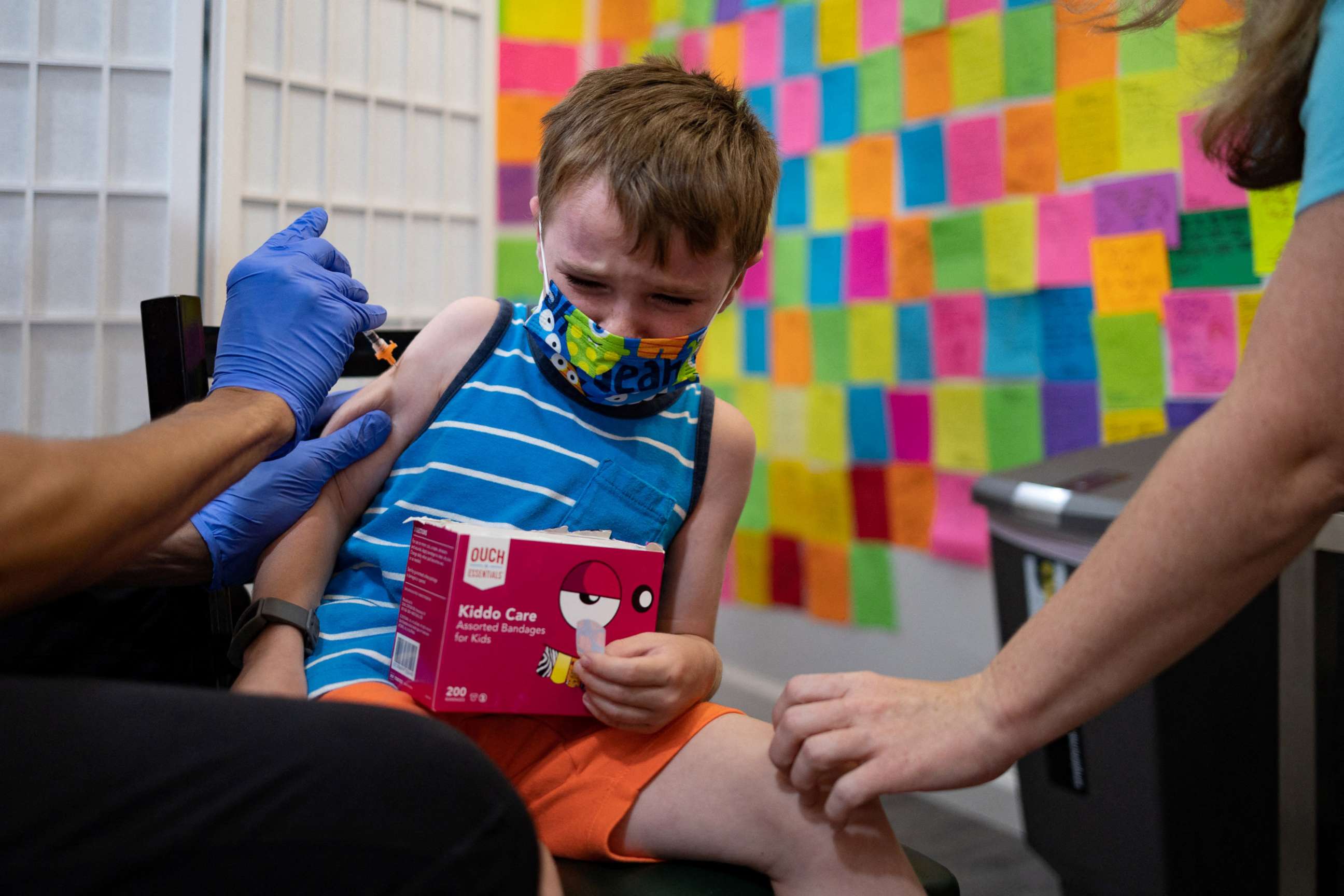Key challenges to vaccinating kids under 5 against COVID-19 and what we can do: Analysis
Challenges include kids not being in school and age limits for pharmacies.
The long-awaited recommendation to authorize the COVID-19vaccines from Moderna and Pfizer/BioNTech for young children is expected to be decided by the Center for Disease Control and Prevention's Advisory Committee on Immunization Practices (ACIP) during its June meeting.
But even once these are authorized for children under 5, public health officials say the vaccine rollout for this age group could be the most challenging yet.
Data from the Kaiser Family Foundation’s (KFF) Vaccine Monitor suggests about 18% of parents with kids under 5 are eager to get their child vaccinated, and most parents say the delay in the approval of the vaccines has not shaken their confidence in their safety and effectiveness.
However, the same survey reports that 27% of parents of children younger than age 5 say they will "definitely not" get their child vaccinated. In addition, more than half of parents of young children say they do not have enough information about the safety and efficacy of the vaccines for the youngest children. The speed of the COVID-19 vaccine rollout for young children will be determined by the vaccine confidence of parents and the ability to recruit qualified providers to administer those doses.
Despite the Pfizer vaccine being available for children ages 5-11 years since November 2021, only 36% of that population has received at least one dose of the vaccine, and only 29.3% has been fully vaccinated, according to the CDC. According to data from Ariadne Labs, Boston Children's Hospital, and Google's Vaccine Equity Planner, in May, only 37% of open vaccination sites in the US offered pediatric COVID-19 vaccinations.
A CDC report demonstrated that early in the rollout, 92% of children ages 5-11 lived within 5 miles of a pediatric vaccination site. However, other barriers must be considered, including access to public transportation, evening and weekend hours availability, and language accommodation.
Strategies of states with among the highest vaccination rates for the 5-11 population were highlighted in the National Academy for State Health Policy's March publication, "State Strategies to Increase COVID-19 Vaccination Rates in Children." While the age 5-11 population has been challenging to vaccinate, the 6- month through 4-year-old population poses additional challenges that will need to be successfully addressed if these children are protected from infection with COVID-19.

Here are the challenges unique to vaccinating young children:
School summer vacation
Schools have played an essential role in hosting vaccination clinics for older children. While the authorization for 5 to 11-year-olds came in October, authorization for the younger children will come in summer when children are no longer in school, effectively eliminating this critical opportunity for vaccinating children in pre-kindergarten programs. Families with young children will need to be reached through childcare centers, early childhood education providers, summer feeding programs, and Women, Infant, and Children (WIC) programs that provide education and vaccination opportunities when children and families are present.
Age limits of pharmacy vaccination
As of June 8, more than 254 million doses (40%) of COVID-19 vaccines have been administered and reported by retail pharmacies. Under the Public Readiness and Emergency Preparedness Act (PREP Act), pharmacists are authorized to order and administer childhood vaccines, including authorized COVID-19 vaccines, to children ages 3-18 years until Oct. 1, 2024. Pharmacies also play a prominent role in the equitable administration of vaccinations as pharmacies are often located within healthcare deserts and offer vaccinations during evening and weekend hours. However, pharmacists do not receive extensive training in vaccinating young children, who are often unwilling to participate in the immunization process. Additionally, most 3-year-old children are vaccinated in the thigh, rather than in the arm, making the vaccination of this age group particularly challenging in a busy pharmacy that may not have the space to ensure privacy during vaccine administration. These unique considerations may result in a significant number of pharmacies unwilling or unable to vaccinate young children despite their accomplishments in vaccinating the adult and school-age populations.
Pediatric provider capacity
Since 1994, the Vaccines for Children Program has provided routine childhood vaccinations to children under the age of 19 who are insured by Medicaid, under-insured, or uninsured. Nationwide, there are nearly 40,000 sites enrolled in the VFC program, vaccinating almost half of all the children in the US and its territories. To participate in the program, physicians must sign an agreement with their state's VFC program. However, this agreement does not include COVID-19 vaccines. The Centers for Disease Control and Prevention (CDC) requires that all COVID-19 vaccine providers sign an agreement directly with the CDC, prohibiting providers from denying vaccination based on the vaccine recipient's insurance coverage. While CDC does not require private providers to vaccinate non-patients, staffing shortages and other factors, may make pediatric providers hesitant to stock the vaccines out of concern that demand will exceed their capacity to provide COVID-19 vaccination services. Additionally, pediatric providers may see only a small number of children ages 6 months through 4 years during regular office hours but lack the staffing capacity to hold special vaccination events.
Vaccine confidence
The KFF Vaccine Monitor is an ongoing project that tracks the public's attitudes and experiences with COVID-19 vaccinations. As of April 2022, only 4% of those surveyed still report they will "wait and see" before getting a vaccine, while 1% still report they would like to be vaccinated "as soon as possible". The remaining individuals surveyed who remain unvaccinated state they will only get the vaccine if required to do so (2%) or definitely will not get the vaccine. Those who remain unvaccinated are largely younger (66% under age 50), white (64%), have less education (47% with a high school diploma or less) and lean Republican (60%).] While only 4% of adults remain in the "wait and see" category, nearly 40% of parents of children under 5 years of age say they want to "wait and see" before getting a vaccine for their child. Another 40% say they will only get their child vaccinated if they are required to do so (11%) or will "definitely not" get their child vaccinated (27%). While a little over half of the parents of children ages 12-17 years say they are confident in the safety of COVID-19 vaccines, only 32% say they are confident about their safety for children under age 5 years. This lack of confidence in vaccine safety for young children, paired with a reported 88 percent of parents feeling their child is "very safe" or "somewhat safe" from exposure to COVID-19 at school, likely means states will face significant challenges when it comes to vaccinating young children.

We can prepare before the end of school year
According to KFF, parents who are encouraged by schools to vaccinate their children are more likely to vaccinate them. Therefore, it will be important to continue to provide vaccine safety messaging to parents in the remaining weeks before school adjourns for the summer and to hold school-based vaccination clinics as soon as students return to school in the fall. The time is now to ensure kids face fewer risks in school and their communities. Public funding is needed to compensate community leaders and pediatricians leading vaccine safety messages to parents and community-based education programs.
Given this data, state and local governments will have summer homework to improve vaccination rates for children when they return to school in the fall:
Respond to the "wait and see" group by providing accurate information on the safety and efficacy of the vaccine through mainstream media, social media, and other channels. Work with schools that send out notices to parents through email or regular mail to include up-to-date information. Partner with influencers in the public education space to get the message out that children will be safer in school if fully vaccinated. Support local health clinics or pediatric offices in terms of hosting or partnering with other organizations to hold "back-to-school" immunization events starting in August.
We know from previous vaccine campaigns that planning and preparation improve the speed and equity of vaccine delivery. So let's start our homework now.
Michelle D, Fiscus, MD FAAP is a pediatrician who most recently served as medical director for the Tennessee Vaccine-Preventable Diseases and Immunization Program. Hemi Tewarson, JD, MPH is the executive director of the National Academy for State Health Policy. Katie Green, MPP, is a project director for population and public health at the National Academy for State Health Policy. Rebecca Weintraub, MD, is an assistant professor at Harvard Medical School and associate physician at Brigham and Women's Hospital and leads Better Evidence at Ariadne Labs. John Brownstein, Ph.D., is an ABC News contributor, the chief innovation officer at Boston Children's Hospital and a professor at Harvard Medical School. The opinions expressed here are not those of ABC News.




